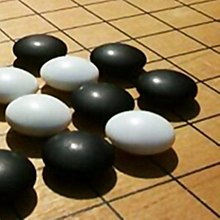This article needs additional citations for verification. (January 2021) |
| Part of a series on |
| Go |
|---|
 |
| Game specifics |
|
| History and culture |
| Players and organizations |
| Computers and mathematics |
A Go opening is the initial stage of a game of Go. On the traditional 19×19 board the opening phase of the game usually lasts between 15 and 40 plies. [citation needed] There is some specialised terminology for go openings. The precise meanings of Japanese language terms is often misunderstood.
A go whole-board opening refers to an opening sequence of plays, almost always laid out the standard 19×19 go board. Because of the symmetry of the board (eight-fold), there are certain conventions about displaying opening moves traditional in Japan. These do not necessarily apply in China or Korea, but naturally in speaking of an 'opening' one never needs to distinguish openings related by symmetry.
The Japanese term for the opening phase of the game is joban, but this is not used in English. Instead it is very common to use fuseki, a Japanese term that has a literal meaning of 'scattering of stones'. This really refers, therefore, to the way the initial plays are distributed around the sides and corners. If the game begins just in one corner, which is rare for high-level play but more common with novices, this is not really fuseki. Also, fuseki may be commonly used as a description for the pattern adopted by Black, the first player, for example, for Black 1-3-5. This ignores White 2 and White 4, and so is really a name for a side formation (for example, Chinese opening) or perhaps a diagonal formation (for example, tasukiboshi, where Black 1 and Black 3 are at 4-4 points in the north-east and south-west corners). The Korean-language term equivalent to fuseki is poseok.
There are also go corner openings. There are many thousands of these standard variations known, related to developments in just one 10×10 corner of the board. In English, they are almost always called joseki; joseki is not a synonym of corner opening, but of standard sequence. The literal meaning in Japanese is of set (i.e., fixed or settled) stones. There are joseki in Go that do not relate to the corner openings. The Korean term equivalent to joseki is jeongseok, often transliterated jungsuk.
In Japanese the 10-10 point on the board (i.e. the center) is called tengen. An opening play at tengen is a kind of experimental opening, and has at times in history been controversial. It may lead to what is called mirror go, in Japanese manego, in which Black imitates White by playing diagonally opposite with respect to the centre stone. There is another style, also called mirror go, where from the beginning of the game White imitates Black in a diagonally-opposite way. The first kind was interesting, for strong players, before the introduction of komidashi, i.e. compensation points for second play. The second kind became interesting only after the introduction of komidashi. Go opening strategy is the strategy applied in Go opening.
There are some conventional divisions that are applied. Firstly there is the distinction that may be drawn between go opening theory, the codified variations that resemble chess openings in the way that they occur repeated in games, and go opening principles. Since there is great freedom of choice, the fundamental opening principles are more useful for all players before they reach dan player level.